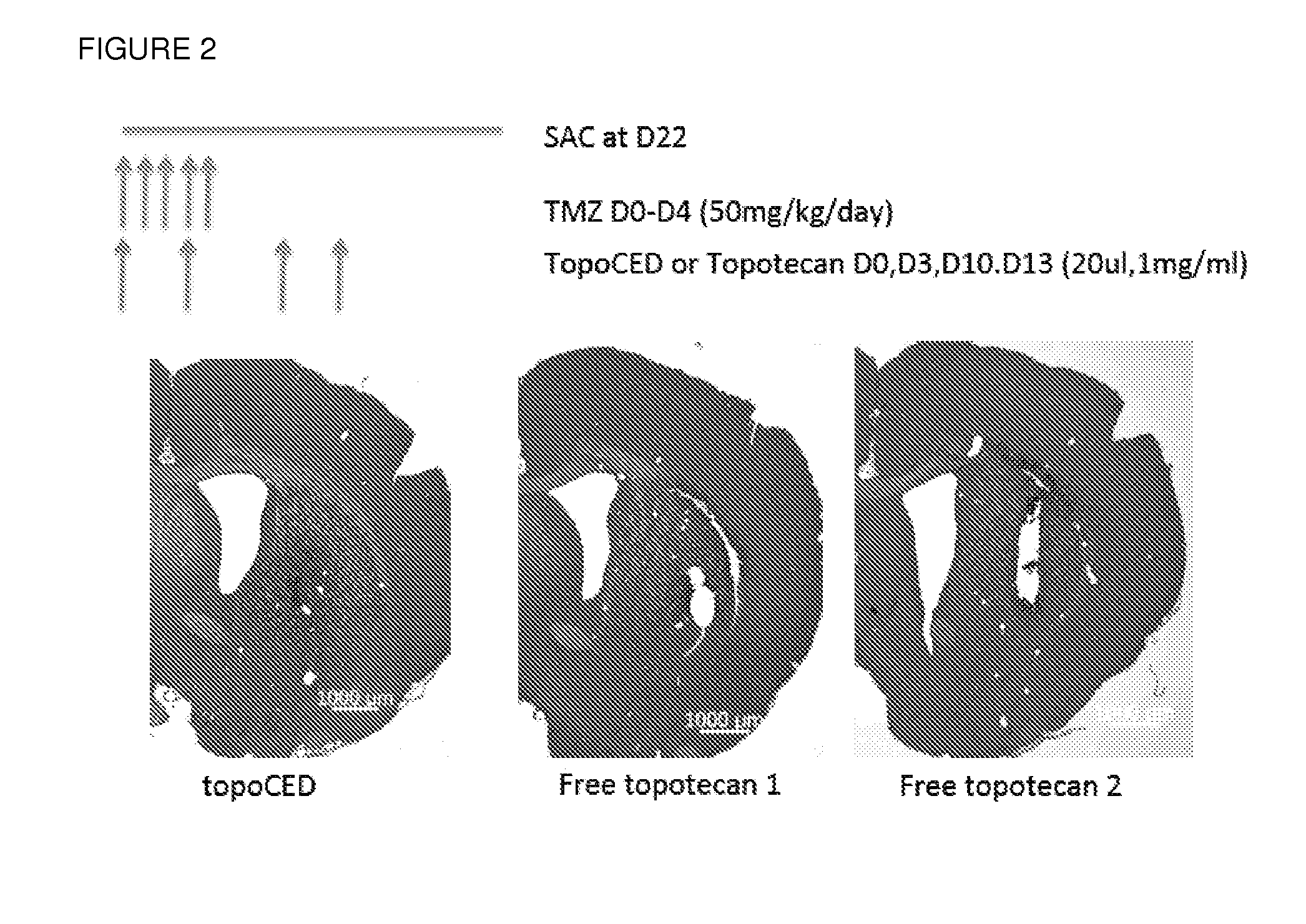Treating Tumors of the Central Nervous System
a central nervous system and tumor technology, applied in the direction of biocide, heterocyclic compound active ingredients, drug compositions, etc., can solve the problems of inability to effectively treat the tumor, poor prognosis of malignant gliomas, and limited systemic treatment effect,
- Summary
- Abstract
- Description
- Claims
- Application Information
AI Technical Summary
Benefits of technology
Problems solved by technology
Method used
Image
Examples
example 1
[0078]A synergistic combined therapy for treatment of glioblastoma was obtained by CED of a convectable non-PEGylated liposomal formulation encapsulating the topoisomerase I inhibitor topotecan (topoCED™); with systemic delivery of TMZ. In animal studies, the combined therapy provided for an increased lifespan of animals in a xenograft model for a human tumor, as shown in FIG. 1. Significantly, the tumors literally melted away in 5 of the 6 animals treated by the subject combination therapy, and only residual tumor was found in the 6th animal.
[0079]Topotecan has been previously tested in a number of clinical studies as a systemic agent combined with radiotherapy; or paclitaxel. Overall, the results of these studies suggest that delivering a large enough concentration of systemic topotecan to kill the tumor cells results in unacceptable systemic toxicity. By infusing the tumor with TopoCED™, instead of the free drug, the toxicity is greatly reduced, as shown in FIG. 2.
[0080]In conclu...
example 2
[0085]CED of TopoCED™ in a canine astrocytoma grade III. Shown in FIG. 3, the largely infused hyperintense area (grey circle) in the T2-weighted image containing the tumor epicenter was located in the caudate nucleus (A). Two areas (encircled in black) containing tumor cells were only minimally infused. The corresponding LFB and HE stained brain sections were examined by light microscopy (B) in order to compare the presence of neoplastic cells in infused versus non-infused areas. Neoplastic cells diminished dramatically in infused areas (C). Neoplastic cells in poorly infused areas were high in numbers and organized as a solid proliferating tumor (D). These marked differences in cell proliferation were highlighted by the reactivity of cells to MIB-1 antibodies.
example 3
[0086]Human glioblastoma multiforme cell line U87MG was maintained as monolayers in Eagle's minimal essential medium supplemented with 10% fetal calf serum, antibiotics (streptomycin 100 ug / ml, penicillin 100 U / ml), and nonessential amino acids. Cells were cultured at 37° C. in a humidified atmosphere of 95% air and 5% carbon dioxide.
[0087]Cells were exposed to TMZ at a concentration of from 50-200 μM for a period of 48 hours, then lysed, immunoprecipitated and run on a gel. The results are shown in FIG. 7 and demonstrate a clear upregulation in topoisomerase I expression with increasing TMZ concentrations. This upregulation provides a compelling explanation for the synergy between TMZ and topoisomerase I inhibitors such as topotecan, although it is important to note that no such synergy has ever been observed in vivo before the concomitant use of systemically administered TMZ with TopoCED™ administered via CED as described in Example 1.
PUM
| Property | Measurement | Unit |
|---|---|---|
| weight percent | aaaaa | aaaaa |
| weight percent | aaaaa | aaaaa |
| flow rate | aaaaa | aaaaa |
Abstract
Description
Claims
Application Information
 Login to View More
Login to View More - R&D
- Intellectual Property
- Life Sciences
- Materials
- Tech Scout
- Unparalleled Data Quality
- Higher Quality Content
- 60% Fewer Hallucinations
Browse by: Latest US Patents, China's latest patents, Technical Efficacy Thesaurus, Application Domain, Technology Topic, Popular Technical Reports.
© 2025 PatSnap. All rights reserved.Legal|Privacy policy|Modern Slavery Act Transparency Statement|Sitemap|About US| Contact US: help@patsnap.com



